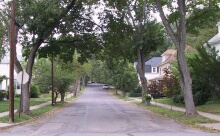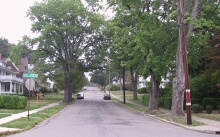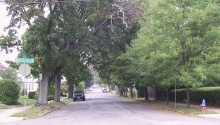A Living Legacy - City Trees
 Mention
the words "The West Side" to people you talk to, and several images come
to mind for those who have passed through the area. Older, Victorian-era
homes, Recreation Park, broad sidewalks and
streets: these are the images that often come to mind. What is often overlooked,
yet sadly acknowledged only after it is gone, are the trees which form
the "urban canopy" over all these things.
Mention
the words "The West Side" to people you talk to, and several images come
to mind for those who have passed through the area. Older, Victorian-era
homes, Recreation Park, broad sidewalks and
streets: these are the images that often come to mind. What is often overlooked,
yet sadly acknowledged only after it is gone, are the trees which form
the "urban canopy" over all these things.
It is these trees, in their subtle, graceful way, which give the West Side that look of an established, permanent place to call home. They add intrinsic value, pedigree and shade to our residences, filter the air we breathe, and forecast the change of seasons all for free. Sadly, despite the numerous benefits, many older, mature trees that line our cities' streets are disappearing at a rapid rate. The leading cause, aside from disease or neglect, is street reconstruction work.
A typical street project starts with the "plans and specifications", which are drawn up by the city Engineering Department. The fate of the trees on that street is decided by an "Urban Forester". This work is currently contracted out to a company called Forestate, of Waverly, New York, a copy of whose business card states it "specializes in management plans, timber marking, timber appraisals, and timber trespasses." Robert Moore, the forester, assesses the trees for general health and determines whether he thinks they will survive the construction process. This information is relayed to the city engineer, who incorporates this analysis into the drawings and written specifications for the project. These documents are then given to contractors to use for bidding the job, and later to direct its progress.
 The
city Engineering Department has a written Tree Policies and Procedures
document. It states that trees are a valuable asset, and that the city
strives to save as many trees as possible. It also describes the Urban
Forester's credentials, methodologies and assessment procedures; this alone
fills four paragraphs. Also mentioned in this paper is the Tree Replacement
Program, as well as procedures for tree trimming by utilities. No mention
is made anywhere of annual or periodic inspection, pruning, dead wood removal,
shaping, or spraying of street trees by the city. No such written maintenance
policy is currently available from the Department of Parks and Recreation,
based upon a telephone request to that office. It is apparent that while
efforts are made to protect trees during street reconstructions, little
additional attention is given to them, until such time as they die, or
a request for action is filed with the city by residents, the city engineer,
or others. This situation raises a question: why would the city have a
written policy to preserve trees during street rebuilds, without
a companion policy to maintain them both beforehand and afterwards?
Is this not a recipe for failure?
The
city Engineering Department has a written Tree Policies and Procedures
document. It states that trees are a valuable asset, and that the city
strives to save as many trees as possible. It also describes the Urban
Forester's credentials, methodologies and assessment procedures; this alone
fills four paragraphs. Also mentioned in this paper is the Tree Replacement
Program, as well as procedures for tree trimming by utilities. No mention
is made anywhere of annual or periodic inspection, pruning, dead wood removal,
shaping, or spraying of street trees by the city. No such written maintenance
policy is currently available from the Department of Parks and Recreation,
based upon a telephone request to that office. It is apparent that while
efforts are made to protect trees during street reconstructions, little
additional attention is given to them, until such time as they die, or
a request for action is filed with the city by residents, the city engineer,
or others. This situation raises a question: why would the city have a
written policy to preserve trees during street rebuilds, without
a companion policy to maintain them both beforehand and afterwards?
Is this not a recipe for failure?
To see whether the city's tree policy was effectively implemented, the WSNA did a case study of Vermont Avenue, which was rebuilt in 1999, and which has many mature trees. Through the Freedom of Information law, we obtained the Plan and Profile drawings, and pertinent written documents originally issued for the project, which indicate that of the 31 trees standing before construction began, 10 were slated to be cut, all of them old, mature trees. Several reasons were stated by the urban forester: some trees were "crowding curb and walk", "under utility lines, heaving curb and sidewalk", "stressed", and "dieback".
Through a vigorous, vocal protest by the residents of that street, seven of the trees were spared from the ax. Ultimately, a re-design of the street, giving more room to the affected trees, allowed this to occur. This approach, which the forester indicated in his assessment report could be utilized to save them initially, was not employed until great protest flared up over the issue. Could not have much time, aggravation, and needless delay been avoided by simply designing around the trees, instead of through them from the start of the project?
In order for the residents impacted by street reconstruction projects to be able to make an informed decision before work commences, the WSNA distributed flyers on February 24, 2001, to all streets slated to be rebuilt that year. If the street has mature trees that might be affected, the flyer directs residents to review the plans and written specifications; if there are currently no trees on it, a flyer was delivered detailing the Tree Replacement Program available to them. In doing this, ample time is given for all questions, comments, and protests to be addressed well before the construction process begins, avoiding delays, confusion, and needless additional costs.
 The
stately trees that line our city streets are the legacy of our forefathers.
It is apparent that policy changes are indicated if we are to preserve
them for future generations. To accomplish this, the mindset must be, wherever
possible, to engineer street work around mature trees instead of
through
them.
This effort must also extend to the trees now being planted as well, to
insure that they grow into healthy, vigorous, and attractive mature trees
that do not entangle utilities or residences. This can be accomplished
through regular inspection, pruning, and shaping.
The
stately trees that line our city streets are the legacy of our forefathers.
It is apparent that policy changes are indicated if we are to preserve
them for future generations. To accomplish this, the mindset must be, wherever
possible, to engineer street work around mature trees instead of
through
them.
This effort must also extend to the trees now being planted as well, to
insure that they grow into healthy, vigorous, and attractive mature trees
that do not entangle utilities or residences. This can be accomplished
through regular inspection, pruning, and shaping.
© Copyright WSNA, Inc. 2001, 2008. All rights reserved.